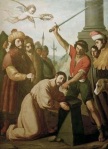I happen to be at Mucknell Abbey, near Worcester, spending a few days on retreat with the Anglican Benediction community here. It’s all part of the sabbatical that I have been on since the beginning of September. Whilst I was here, however, I asked if I could meet the member of the community who is responsible for the manufacture of incense. That person is Sister Sally. So this morning she kindly took time between Offices and her other responsibilities to show me round the shed in the abbey grounds that serves as her workshop (her real workshop is of course the Oratory where the real work of prayer is done).

Sister Sally in her workshop
The reason I’m posting this on the Camino Blog is that it was a box of incense from Mucknell Abbey that we presented at the Pilgrim Mass at the conclusion of our pilgrimage. On that occasion around 60 members of the congregation from Southwark Cathedral joined the thousand or so who filled the Cathedral to give thanks for the blessings of the pilgrimage. I had the honour of making the invocation to the Apostle on behalf of all the pilgrims who were at the Mass and, as part of that, offering some incense to feed the Botafumeiro, the great beast of a thurible that swings over the heads of the those there!
The Abbey produces six different mixes of incense ranging from pure frankincense to more elaborate and complex mixes. I’ve been in churches that have used incense all my life but never knew how it was made.
Sister Sally introduced me to the frankincense, the raw ingredient, also called Olibanum. The abbey sources theirs from Ethiopia. It’s collected from the trees by incising the bark and then, as sister described it, the tree ‘weeps tears of incense’. This is dried and it becomes granular. The mixes are created by the addition of other granular and powdery ingredients, like Myrrh and Cinnamon Bark but principally through the use of aromatic oils.

The cupboard of oils
I was shown the secret recipes which had been passed to the community from the monks at Nashdom when they stopped producing it. All the ingredients are mixed together in the correct quantities using old fashioned scales and other non-digital devices and then laid in trays to dry out. The drying takes 1-2 weeks depending on how damp the mixture is. In the trays it looks like a dark muesli bar and is quite solid, but then it dries and the granules separate so that it can be weighed, bagged, boxed and shipped.

Bagged and boxed and ready for use
It was fascinating to see and to smell the finished products in the huge tubs that is kept in until its sent out not just to churches in these islands but to America and Australia as well. Sister Sally obviously loved the work that she does. She commented that she hoped that the Abbot wouldn’t move her to other responsibilities. She says that while she is weighing and mixing she prays for the congregations that will use the incense in their worship.

Sister Sally joyful in work and prayer
Of course the church is divided into those who love incense and its smell and those who think its an abomination. Yet whatever our own personal and sometimes visceral response there is that verse from the psalms which really helps us understand what we are doing when we light the coals and spoon in the incense that Sister Sally has so carefully and prayerfully made
Let my prayer rise before you as incense,
the lifting up of my hands as the evening sacrifice. (Ps 141.2)
If you would like to buy some of Sister Sally’s incense then you can do so by clicking here. It will enhance your worship and support the brothers and sisters here as their own prayer rises like the incense they make.
Lord, let me prayer rise before you as incense,
my hands be lifted up in a sacrifice of praise.
Amen.



















You must be logged in to post a comment.